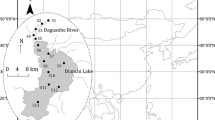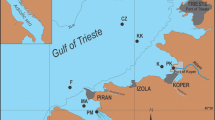Abstract
This paper presents the spatial and temporal characteristics of petroleum hydrocarbons (PH) in surficial sediments from the Songhuajiang River using the method of petroleum chemical fingerprinting. Twenty-four surface sediment samples were collected at 17 sites along the river from upstream to downstream in flood season (August 2005) and icebound season (December 2005) and were analyzed for PH including n-alkanes (C16–C33), isoprenoid alkanes (pristane and phytane), and unresolved complex mixture (UCM). The concentration of PH varied from 22.64 to 91.45 μg g − 1 dry sediment. n-alkanes with a carbon number from 16 to 33 were detected in all samples, and the UCM was the dominant composition for PH. The variability of the PH concentration was mostly influenced by external conditions, such as seasonal change and industrial area position, as well as internal sediment physicochemical properties, such as organic carbon and grain size. The concentration of hydrocarbons is higher in flood season than in icebound season and is higher upstream than downstream. The diagnostic ratios of specific hydrocarbons showed that the PH pollution comes from a combination of biogenic and petrogenic sources, and petrogenic input is dominant in icebound season relative to flood season. It also indicates that there is a clear terrigenous input of n-alkanes in flood season. Principal components analysis was used to study the composition and characteristics of PH in Songhuajiang River sediments and to assess the spatial and temporal distribution of their natural and anthropogenic sources.
Similar content being viewed by others
References
Azimi, S., Rocher, V., Muller, M., Moilleron, R., & Thevenot, D. R. (2005). Sources, distribution and variability of hydrocarbons and metals in atmospheric deposition in an urban area (Paris, France). Science of the Total Environment, 337, 223–239.
Beg, M. U., Saeed, T., Al-Muzaini, S., Beg, K. R., & Al-Bahloul, M. (2003). Distribution of petroleum hydrocarbon in sediment from coastal area receiving industrial effluents in Kuwait. Ecotoxicology and Environmental Safety, 54, 47–55.
Boehm, P., & Requejo, A. G. (1986). Overview of the recent sediment hydrocarbon geochemistry of Atlantic and Gulf coast outer continental shelf environments. Estuarine, Coastal and Shelf Science, 23, 29–58.
Bouloubassi, I., & Saliot, A. (1993). Investigation of anthropogenic and natural organic inputs in estuarine sediments using hydrocarbon markers (NAH, LAB, PAH). Oceanologica Acta, 16(2), 145–161.
Bourbonniere, R. A., & Meyers, P. A. (1996). Anthropogenic influences on hydrocarbon contents of sediments deposited in eastern Lake Ontario since 1800. Environmental Geology, 28, 22–28.
Bray, E. E., & Evans, E. D. (1961). Distribution of n-paraffins as a clue to recognitions of source beds. Geochimica Et Cosmochimica Acta, 22, 2–9.
Broman, D., Colmsjo, A., Ganning, B., Naf, C., Zebuhr, Y., & Ostman, C. (1987). Fingerprinting petroleum hydrocarbons in bottom sediment, plankton, and sediment trap collected seston. Marine Pollution Bulletin, 18(7), 380–388.
Carro, N., Cobas, J., & Maneiro, J. (2006). Distribution of aliphatic compounds in bivalve mollusks from Galicia after the Prestige oil spill: Spatial and temporal trends. Environmental Research, 100, 339–348.
Chouksey, M. K., Kadam, A. N., & Zingde, M. D. (2004). Petroleum hydrocarbon residues in the marine environment of Bassein-Mumbai. Marine Pollution Bulletin, 49, 637–647.
Colombo, J. C., Cappelletti, N., Lasci, J., Migoya, M. C., Speranza, E., & Skorupka, C. N. (2005). Sources, vertical fluxes, and accumulation of aliphatic hydrocarbons in coastal sediments of the Río de la Plata Estuary, Argentina. Environmental Science & Technology, 39, 8227–8234.
Colombo, J. C., Pelletier, E., Brochu, Ch., Khalil, M., & Catoggio, J. A. (1989). Determination of hydrocarbon sources using n-alkane and polyaromatic hydrocarbon distribution indexes. Case study: Rio de La Plata Estuary, Argentina. Environmental Science & Technology, 23, 888–894.
Commendatore, M. G., & Esteves, J. L. (2004). Natural and anthropogenic hydrocarbons in sediments from the Chubut River (Patagonia, Argentina). Marine Pollution Bulletin, 48, 910–918.
Commendatore, M. G., Esteves, J. L., & Colombo, J. C. (2000). Hydrocarbons in coastal sediments of Patagonia, Argentina: Levels and probable sources. Marine Pollution Bulletin, 40(11), 989–998.
Cui, C. J., & Zhai, P. Y. (2005). Prevention and control of bio-pollution of organic toxicant in Song-hua River. North Environment, 30(2), 24–26 (in Chinese).
Farrington, J. W., & Tripp, B. W. (1977). Hydrocarbons in western North Altantic surface sediments. Geochimica Et Cosmochimica Acta, 41, 1627–1641.
Faure, P., Elie, M., Mansuy, L., Michels, R., Landais, P., & Babut, M. (2004). Molecular studies of insoluble organic matter in river sediments from Alsace-Lorraine (France). Organic Geochemistry, 35, 109–122.
Faure, P., Landais, P., & Griffault, L. (1999). Behavior of organic matter from Callovian shales during low temperature air oxidation. Fuel, 78, 1515–1525.
Gao, X. L., Chen, S. Y., Xie, X. L., Long, A. M., & Ma, F. J. (2007). Non-aromatic hydrocarbons in surface sediments near the Pearl River estuary in the South China Sea. Environmental Pollution, 148, 40–47.
Gilbert, M., Rivet, L., Jawad, A. I., & Bertrand, J. C. (1992). Hydrocarbon distributions in low polluted surface sediments from Kuwait, Bahrain and Oman Coastal Zones (Before the Gulf War). Marine Pollution Bulletin, 24, 622–626.
Guo, W., He, M. C., Yang, Z. F., Lin, C. Y., Quan, X. C., & Wang, H. Z. (2007). Comparison of polycyclic aromatic hydrocarbons in sediments from the Songhuajiang River (China) during different sampling seasons. Journal of Environmental Science and Health. Part A, 42(2), 119–127.
Harji, R., Yvenat, A., & Bhosle, B. B. (2008). Sources of hydrocarbons in sediments of the Mandovi estuary and the Marmugoa harbour, west coast of India. Environment International, 34, 959–965.
Jeanneau, L., Faure, P., Montarges-Pelletier, E., & Ramelli, M. (2006). Impact of a highly contaminated river on a more important hydrologic system: Changes in organic markers. Science of the Total Environment, 372, 183–192.
Jeng, W. L., & Huh, C. A. (2006). A comparison of sedimentary aliphatic hydrocarbon distribution between the southern Okinawa Trough and a nearby river with high sediment discharge. Estuarine, Coastal Shelf Science, 66, 217–224.
Kennicutt, II, M. C., Barker, C., Brooks, J. M., DeFreitas, D. A., & Zhu, G. H. (1987). Selected organic matter source indicators in the Orinoco, Nile and Changjiang deltas. Organic Geochemistry, 11, 41–51.
Mazurek, M. A., & Simoneit, B. R. T. (1984). Characterization of biogenic and petroleum-derived organic matter in aerosols over remote, rural and urban areas. In: L. H. Keith (Ed.), Identication and analysis of organic pollutants in air (pp 353–378). Boston: Ann Arbor Science/Butterworth.
Medeiros, P. M., Bícego, M. C., Castelao, R. M., Rosso, C. D., Fillmann, G., & Zamboni, G. A. J. (2005). Natural and anthropogenic hydrocarbon inputs to sediments of Patos Lagoon Estuary, Brazil. Environment International, 31, 77–87.
Nemirovskaya, I. A., Brekhovskikh, V. F., & Kazmiruk, V. D. (2006). Aliphatic and polycyclic hydrocarbons in bottom sediments of offshore mouth area of the Volga. Water Resources, 33(3), 274–284.
Readman, J. M., Mantoura, R. F. C., & Rhead, M. M. (1987). A record of polycyclic aromatic hydrocarbons (PAH) pollution obtained from accreting sediments of the Tamar estuary, UK: Evidence for non equilibrium behaviour of PAH. Science of the Total Environment, 66, 73–94.
Readman, J. W., Fillmann, G., Tolosa, I., Bartocci, J., Villeneuve, J. P., Catini, C., et al. (2002). Petroleum and PAH contamination of the Black Sea. Marine Pollution Bulletin, 44, 48–62.
Rieley, G., Collier, R. J., Jones, D. M., & Eglinton, G. (1991). The biogeochemistry of Ellesmere Lake, U.K.-I: Source correlation of leaf wax inputs to the sedimentary lipid record. Organic Geochemistry, 17, 901–912.
SEPA of China (2004). Tenth-five-year plan of water pollution prevention and control for “three rivers and three lakes”. Beijing: Chemical industry publishing company.
Simoneit, B. R. T. (1982). Some applications of computerized GC-MS to the determination of biogenic and anthropogenic organic matter in environment. International Journal of Environmental Analytical Chemistry, 12, 177–193.
Simoneit, B. R. T. (1984). Organic matter of the troposphere. III. Characterization and sources of petroleum and pyrogenic residues in aerosols over the western United States. Atmospheric Environment, 18, 51–67.
Steinhauer, M. S., & Boehm, P. D. (1992). The composition and distribution of saturated and aromatic hydrocarbons in nearshore sediments, river sediments, and coastal peat of Alaskan Beaufort Sea: Implications for detecting anthropogenic hydrocarbon inputs. Marine Environmental Research, 33, 223–253.
Tolosa, I., Mora, S. D., Sheikholeslami, M. R., Villeneuve, J. P., Bartocci, J., & Cattini, C. (2004). Aliphatic and aromatic hydrocarbons in coastal Caspian Sea sediments. Marine Pollution Bulletin, 48, 44–60.
UNEP (1992). Determination of petroleum hydrocarbons in sediments. Reference Methods For Marine Pollution Studies No. 20.
Volkman, J. K., Holdsworth, D. G., Neill, G. P., & Bavor, Jr., H. J. (1992). Indentification of natural, anthropogenic and petroleum hydrocarbons in aquatic sediments. Science of the Total Environment, 112, 203–219.
Ye, B. X., Zhang, Z. H., & Mao, T. (2007). Petroleum hydrocarbon in surfical sediment from rivers and canals in Tianjin, China. Chemosphere, 68, 140–149.
Zakaria, M. P., Horinochi, A., Tsutsumi, S., Takada, H., Tanabe, S., & Ismail, A. (2000). Oil pollution in the straits of Malacca, Malaysia: Application of molecular markers for source identification. Environmental Science & Technology, 34, 1189–1196.
Author information
Authors and Affiliations
Corresponding author
Rights and permissions
About this article
Cite this article
Guo, W., He, M., Yang, Z. et al. Characteristics of petroleum hydrocarbons in surficial sediments from the Songhuajiang River (China): spatial and temporal trends. Environ Monit Assess 179, 81–92 (2011). https://doi.org/10.1007/s10661-010-1720-0
Received:
Accepted:
Published:
Issue Date:
DOI: https://doi.org/10.1007/s10661-010-1720-0




